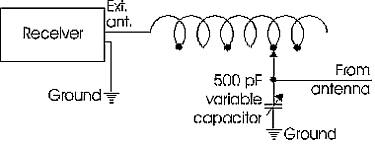|
Simple antenna tuner
by Brian
Carling
This
device can be built in a box or "open-frame", even sitting
on your desk in a jumble will work! It is an "L Network."
The variable
capacitor can be any 0-500 pF capacitor, preferably with a
1/4" shaft that you can put a convenient knob on. A trimmer capacitor
is not recommended.
You could also use a 0-365 pf capacitor since these are commonly
available.
|
One
user says:
I built the tuner just as described into a nice metal box,
and I used house electrical grounding.
At night, I get sometimes better reception on 6 MHz with
an ATS909 and this arrangement than I get with a DX-394
with an MFJ-956 tuner, and a 40 foot T2FD outside. (By
KC2CAU)
|
You may also
add a fixed 500 pF silver mica capacitor parallel to the variable
tuning capacitor in order to tune the lowest frequencies.
Variable capacitors and fixed capacitors are available from Antique
Radio Supply, 6221 S. Maple Ave., Tempe, AZ 85283. Phone (602)
820-5411 for a catalog. They also have coil forms and various
useful supplies.
Note: When mounting the variable capacitor be sure to use
small screws that will not interfere with the movement of the
plates. It is very easy to ruin a variable capacitor if you are
not used to handling them, because the plates get bent easily.
One connection is to the frame of the variable capacitor. The
other is to the fixed plates via a solder terminal.
You will
also need a rotary switch (single pole is sufficient, but
if a switch on hand has 2 or more poles, just don't use the extra
ones!).
The number of positions is not too critical, but the more taps
and switch positions you use, obviously the better match you will
obtain for the frequencies you wish to hear. Radio Shack has a
suitable 12 position single pole rotary switch that they sell
for only $1.39 (in 1992)
Note that Radio Shack also has project cases that you could build
the tuner into fairly easily. Just be sure you have enough room
for the variable capacitor when the plates are open!
For regular
SWL work in the 3-30 MHz range, the coil should be about 100
or 120 turns of insulated wire on a 1" diameter coil form. You
can use 24 gauge magnet wire or plastic covered wire. Scrape the
insulation off for the tap points if it is enamel covered magnet
wire. If you are using plastic insulated wire, use wire strippers
to remove about 1/2" of the insulation to make a connection at
the tap. Tap point can be twisted together for easier access in
order to solder on the wires that go over to the switch.
Note: If you have not learned to solder properly do not attempt
this project.
The coil
diameter is not particularly critical. The coil form can be
a commercially bought coil form or a pill bottle or any plastic,
glass or cardboard device (not metal!). The coil must be
tapped approximately every ten turns. This means you have to make
a little loop in the wire and strip off the insulation so you
can connect to it with a wire over to the switch, or connect to
the tap with an alligator clip instead of the switch. However,
that is a cheapo undesirable way to do it!
If you want
to receive below 500 kHz, you will need to add a 1000 pF
capacitor in parallel with the variable capacitor.
Also, make the coil larger.
You should use a coil of 2-300 turns about 2 inches in diameter
with several taps and a switch to select taps (or use an alligator
clip). You should also use a capacitor to ground to complete the
'L' such as a 500 pF variable that goes from the antenna side
to ground. The coil and capacitor would both attach to the antenna,
but only the coil would go to the receiver's antenna terminal.
If this still doesn't help for VLF, I would add another 500 or
1000 pF fixed capacitor in parallel with the 500 pF variable.
Once you
get the right combination of coil inductance and capacitance
you'll be amazed how much difference it makes to your signal reception
either on the SW broadcast bands, or below them with the larger
coil and capacitance.
Note that this type of tuner is designed to be used with random
wire antennas that are generally shorter than 1/4 wavelength at
the received frequency. For example on the 41 meter band (approx
7 MHz), a 1/4 wavelength wire would be 32 feet long. For the 11
meter band (25.8 MHz) a 1/4 wavelength would be 9 feet long.
For general shortwave listening this antenna tuner will work very
well with a straight wire of up to 50 or even 75 feet in length.
For those too lazy to build this (or too much money to care!),
you can buy a similar tuner made by MFJ enterprises for about
$40.00 that is reported to work very well, and comes in an attractive
metal mini cabinet.
Always
keep antenna wires away from all power lines and electrical
wiring both for safety and noise reduction.
Never erect an antenna in a place where it has any possibility
of falling across power lines or electrical equipment.
The author assumes no liability for the construction, effectiveness
or safety of this device.
Simple
antenna tuner:

Switch
wiring:


(This article originally appeared on FidoNet's
SWL echo in December 1991)
|



